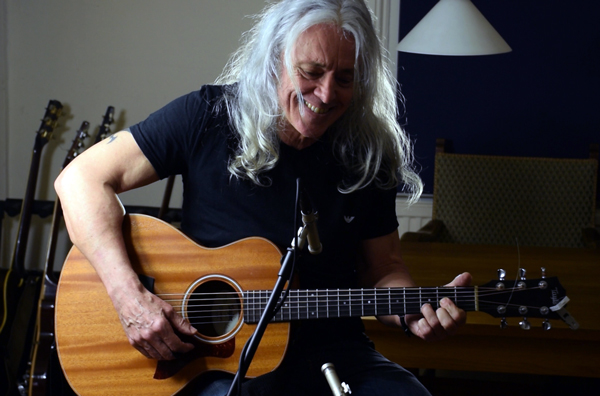Playing the riff and guitar break from the
acoustic version of Starlight Coast Express
My Mini Taylor GS, made of mahogany with great-sounding pickup and eq volume controls for amplification at live gigs, was not a guitar that I would have thought to buy. It’s small, which made me think it wasn’t going to sound as full as an acoustic should sound. And with a neck that’s two inches shorter than the normal, I thought the frets were going to feel squashed together.
My favourite acoustic guitar is a 1960’s Gibson J-45. The others are also steel stringed and full size, with pickups and electronics that I’ve fitted (so I know exactly how they’re going to sound through a PA).
I won my Mini GS in a Taylor promotion at my local music shop – PMT in Oxford, as part of their opening a larger store. In fact what I actually won was a bog-standard, bottom-of-the-range sitka spruce model with no electronics. But the excellent guys in the shop know me, and so with gigging in mind, were persuaded to swap it (with cash to make up the difference) for one with the electronics. But, with much apology, they could only source the model with the mahogany top, so I “made do” with that!!
I carried my new friend home in its dedicated and very smart, semi-rigid padded backpack case. In the familiar acoustics of my home music room, I discovered that this small guitar has an amazing bottom end, and is loud! The strings helped – a medium gauge (13-53) special Taylor phosphor bronze mix; but even so, the tone from this scaled-up ukulele was remarkable.
I was recording the following week, so took my new guitar along to show producer Jez Coad. We’re both serious guitar geeks, and everybody wants to flaunt a freebie. I also took the J-45 for actual use. But we ended up only using the Taylor, as it recorded so sweetly. Jez had bought a mini Martin for recording – the Ed Sheeran model, but rapidly conceded that the Taylor was very much better.
The small size of the body in fact means the Mini GS doesn’t produce as much of the lower frequencies that make feedback such a problem for live performances – especially working alongside electric guitars and drummers. When recording, you always filter out these low frequencies , as they make the mix sound muddy.
My concern about lack of volume was plain wrong; and it’s also totally fine to play. The neck turns out to be only 1/16th of an inch narrower than standard, with none of the small-scale problems that I’ve had playing other guitars.
That first studio session with the Taylor turned out also to be the start of a very big change for me. I’d been warming up my voice, singing with the Taylor at the back of the studio, and Jez was listening – checking out how I’d incorporated the various guitar parts from the previous tracks we’d recorded in earlier sessions.
Anyway, after various good points were made, Jez advised me to stop playing the solo acoustic versions of my songs using the usual flat pick plectrum style that we rock guitarists invariably use when going “unplugged”.
“It would be much more interesting if you used your fingers,” he said.
“In any case, using the pick means the guitar is louder than your vocal. The vocal must always take precedence – and so be louder. At gigs, microphones don’t do us many favours – so we don’t usually notice this.”
So as with everything Jez is kind enough to suggest to me, I took this to heart, and over several months, radically altered how I play. It wasn’t easy – a simple suggestion that became a huge change in how I’d been playing my songs with just a guitar and me.
The Mini Taylor was the catalyst. Strangely, played with fingers, the mini Taylor is very clearly defined – far more so than the J-45. It’s also louder, but “clearly defined” is a better way of describing it. You don’t need finger picks – or at least you don’t once you’re the ends of your fingers have toughened up!
It became possible to imagine how various melody lines and guitar details could be included into my solo acoustic versions. Very exciting for me!! (And hopefully not too geeky for you…. )
And, of course, now I want a concert-size Taylor – which is is why Taylor were giving these away to the likes of me in the first place….
As further confirmation of my inevitable purchase of a further Taylor more expensive than the one they gave me, Taylor has now developed a radical new method of bracing the tops of their acoustics (called V bracing), which they claim greatly increases tuning, clarity etc. Judging by the Mini GS, I totally believe this – which is confirmed by my singer-songwriter friend Dan Rawles who’s the guitar specialist at PMT and has played one. So once Taylor build this innovation into one of their less expensive models, I will “need” to have one…
Final Note – Top of the range acoustic guitars are slathered with carvings, multi-coloured beading, inlays of mother-of-pearl birds, butterflies, cowboy insignia etc. It’s all wonderful stuff! But makes a guitar look like it’s worth stealing, plus ramps the price up hugely. Whereas when I’m playing, all I see is the side of the fingerboard and the top of the body.
So when I say “less expensive”, I mean the model point at which you’re paying for a minimum amount of guitar “bling” but a maximum amount of guitar quality – sound, playability, wood etc.

